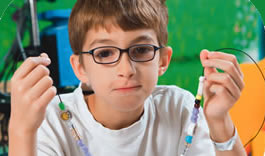Beads of Hope
Craft Helps Children Cope with Cancer Treatment
Jenni Gretzema holds a red-amber bead between her finger and thumb and asks 10-year-old Logan MacGregor if he knows how many blood draws he's had during his week-long stay in C.S. Mott Children's Hospital.
Child and Family Life programs are now offered through C.S. Mott Children's Hospital's Child & Family LIfe.

"I'd say 16," he says without hesitation. He's been keeping track. Blood draws aren't easy for Logan, who has just been diagnosed with chronic myelogenous leukemia. His mom, Helen, says he hyperventilated each time until Gretzema taught him some breathing techniques to help calm him.
"Jenni's a godsend. The tone of her voice is so soothing," Helen MacGregor says. "The doctors and nurses are wonderful, but they talk to us as parents. Jenni sits down and talks to him, one-on-one."
Gretzema is a child life specialist. Her job is to help kids find ways to cope with what it means to be a pediatric cancer patient. Today, she's using hope beads, a crafting project that assigns meaning to individual beads. Children string the beads into jewelry documenting their medical experiences.
As Logan threads eight red-amber beads representing each day of blood draws -- or "pokes" -- he's endured, Jenni talks with him.
"Do you know what it means to cope?"
"No."
"It means what you do to get through your pokes."
By the time Logan finishes, his necklace is nearly two feet long and strung with meaning: A big blue bead with a yellow moon and star marks his first overnight stay in the hospital. A smiley face with a nurse's hat reminds him of his favorite nurse. White hearts and pink beads represent procedures he's undergone or special people who have visited. A round wooden bead with a house drawn on it caps the necklace. It's his favorite bead, the "going home" bead -- an accomplishment still on the horizon.
As Logan wheels the IV pole he's dubbed "Frank" -- because it's as tall as Frankenstein -- back to his room on Mott's seventh floor, Gretzema says the hope beads are helpful in getting kids to talk about their emotions. They help kids regain a sense of control. They also give them a tangible representation of what they've been through. Often, kids take their hope beads to school to show friends.
"It helps them take pride in their courage and acknowledges that what they've experienced is difficult," Gretzema says. "They can use the hope beads to say, 'Look at what I've been through.'"
Continue reading the Fall, 2009 issue of Thrive.
